HetaSimulator is an OpenSource simulation and parameters estimation (fitting) platform for the Heta modeling language. The main purpose of the package is to establish the linkage between emerging QSP frameworks and fast computational methods (parallel simulations, automatic differentiation, etc.).
The latest documentation can be found here: https://hetalang.github.io/HetaSimulator.jl/dev/.
See the ROAD MAP for future implementations.
Heta language is a domain-specific modeling language (DSL) for dynamic models used in quantitative systems pharmacology (QSP) and systems biology (SB). The Heta code and the tables can be translated into variety of formats like Simbiology, Matlab, mrgsolve, DBSolve and many others.
This package provides the simulation engines for the Heta-based models and modeling platforms to be run in Julia. A QSP model can be directly run using the HetaSimulator without additional tools. The ODE system in general form can also be run with HetaSimulator.
Internally HetaSimulator utilizes the facilities of OpenSource projects like Julia and SciML ecosystem.
It is assumed that you have Julia installed. The latest Julia release can be downloaded from julialang.org
To install or update HetaSimulator and Heta compiler run the code below in Julia environment:
julia> ]
(@v1.6) pkg> add HetaSimulatorInternally HetaSimulator uses Heta compiler. Sometimes it is required to update the compiler's version.
# update heta compiler for v0.6.10
julia> heta_update("0.6.10") Create a model in Heta format or use your Heta-based platform. Here we will use the example with a simple model with two species and one reaction.
// index.heta file in directory "my_project"
comp1 @Compartment .= 1.5;
s1 @Species {compartment: comp1, output: true} .= 12;
s2 @Species {compartment: comp1, output: true} .= 0;
r1 @Reaction {actors: s1 => s2, output: true} := k1 * s1 * comp1;
k1 @Const = 1e-3;
To read more about Heta code read Heta specifications
using HetaSimulator, Plots
# set the absolute or relative path to the project directory
platform = load_platform("./my_project")
# wait for the platform compilation...
# get the base Heta model
model = platform.models[:nameless]
# single simulation and plot
results = Scenario(model, (0., 1200.)) |> sim
plot(results)# transform results to data frame
df = DataFrame(results)
...
9×4 DataFrame
Row │ t s1 s2 scope
│ Float64 Float64 Float64 Symbol
─────┼─────────────────────────────────────────────
1 │ 0.0555525 11.9993 0.000666611 ode_
2 │ 0.611077 11.9927 0.00733069 ode_To read more about available functions, see the documentation
- Read the docs
- Use Gitter Chatroom.
- Use Issue Tracker
- Source Code
- Issue Tracker
- See also contributing in Heta project
This package is distributed under the terms of the MIT License.
Copyright 2020-2022, InSysBio LLC




